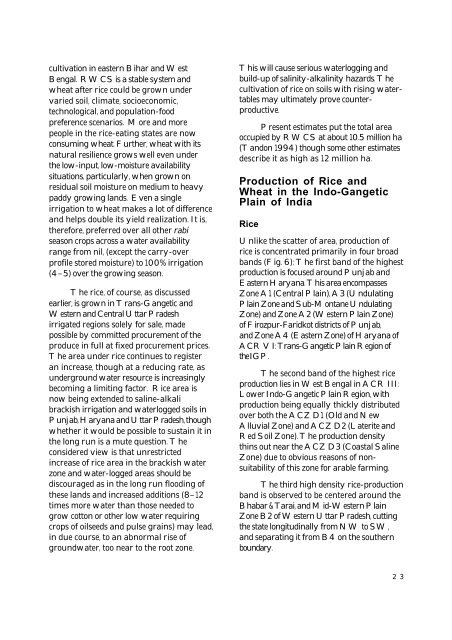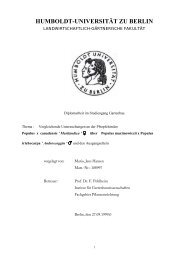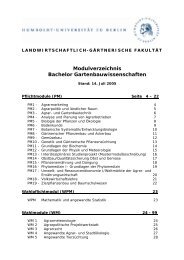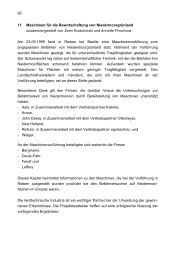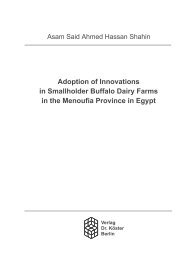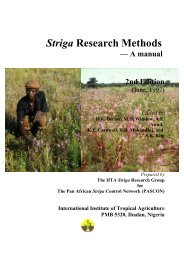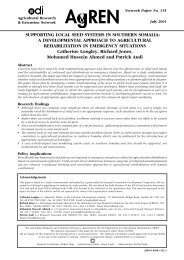Rice-Wheat Cropping Systems of the Indo-Gangetic Plain of India
Rice-Wheat Cropping Systems of the Indo-Gangetic Plain of India
Rice-Wheat Cropping Systems of the Indo-Gangetic Plain of India
Create successful ePaper yourself
Turn your PDF publications into a flip-book with our unique Google optimized e-Paper software.
cultivation in eastern Bihar and West<br />
Bengal. RWCS is a stable system and<br />
wheat after rice could be grown under<br />
varied soil, climate, socioeconomic,<br />
technological, and population-food<br />
preference scenarios. More and more<br />
people in <strong>the</strong> rice-eating states are now<br />
consuming wheat. Fur<strong>the</strong>r, wheat with its<br />
natural resilience grows well even under<br />
<strong>the</strong> low-input, low-moisture availability<br />
situations, particularly, when grown on<br />
residual soil moisture on medium to heavy<br />
paddy growing lands. Even a single<br />
irrigation to wheat makes a lot <strong>of</strong> difference<br />
and helps double its yield realization. It is,<br />
<strong>the</strong>refore, preferred over all o<strong>the</strong>r rabi<br />
season crops across a water availability<br />
range from nil, (except <strong>the</strong> carry-over<br />
pr<strong>of</strong>ile stored moisture) to 100% irrigation<br />
(4–5) over <strong>the</strong> growing season.<br />
The rice, <strong>of</strong> course, as discussed<br />
earlier, is grown in Trans-<strong>Gangetic</strong> and<br />
Western and Central Uttar Pradesh<br />
irrigated regions solely for sale, made<br />
possible by committed procurement <strong>of</strong> <strong>the</strong><br />
produce in full at fixed procurement prices.<br />
The area under rice continues to register<br />
an increase, though at a reducing rate, as<br />
underground water resource is increasingly<br />
becoming a limiting factor. <strong>Rice</strong> area is<br />
now being extended to saline-alkali<br />
brackish irrigation and waterlogged soils in<br />
Punjab, Haryana and Uttar Pradesh, though<br />
whe<strong>the</strong>r it would be possible to sustain it in<br />
<strong>the</strong> long run is a mute question. The<br />
considered view is that unrestricted<br />
increase <strong>of</strong> rice area in <strong>the</strong> brackish water<br />
zone and water-logged areas should be<br />
discouraged as in <strong>the</strong> long run flooding <strong>of</strong><br />
<strong>the</strong>se lands and increased additions (8–12<br />
times more water than those needed to<br />
grow cotton or o<strong>the</strong>r low water requiring<br />
crops <strong>of</strong> oilseeds and pulse grains) may lead,<br />
in due course, to an abnormal rise <strong>of</strong><br />
groundwater, too near to <strong>the</strong> root zone.<br />
This will cause serious waterlogging and<br />
build-up <strong>of</strong> salinity-alkalinity hazards. The<br />
cultivation <strong>of</strong> rice on soils with rising watertables<br />
may ultimately prove counterproductive.<br />
Present estimates put <strong>the</strong> total area<br />
occupied by RWCS at about 10.5 million ha<br />
(Tandon 1994) though some o<strong>the</strong>r estimates<br />
describe it as high as 12 million ha.<br />
Production <strong>of</strong> <strong>Rice</strong> and<br />
<strong>Wheat</strong> in <strong>the</strong> <strong>Indo</strong>-<strong>Gangetic</strong><br />
<strong>Plain</strong> <strong>of</strong> <strong>India</strong><br />
<strong>Rice</strong><br />
Unlike <strong>the</strong> scatter <strong>of</strong> area, production <strong>of</strong><br />
rice is concentrated primarily in four broad<br />
bands (Fig. 6): The first band <strong>of</strong> <strong>the</strong> highest<br />
production is focused around Punjab and<br />
Eastern Haryana. This area encompasses<br />
Zone A1 (Central <strong>Plain</strong>), A3 (Undulating<br />
<strong>Plain</strong> Zone and Sub-Montane Undulating<br />
Zone) and Zone A2 (Western <strong>Plain</strong> Zone)<br />
<strong>of</strong> Firozpur-Faridkot districts <strong>of</strong> Punjab,<br />
and Zone A4 (Eastern Zone) <strong>of</strong> Haryana <strong>of</strong><br />
ACR VI: Trans-<strong>Gangetic</strong> <strong>Plain</strong> Region <strong>of</strong><br />
<strong>the</strong> IGP.<br />
The second band <strong>of</strong> <strong>the</strong> highest rice<br />
production lies in West Bengal in ACR III:<br />
Lower <strong>Indo</strong>-<strong>Gangetic</strong> <strong>Plain</strong> Region, with<br />
production being equally thickly distributed<br />
over both <strong>the</strong> ACZ D1 (Old and New<br />
Alluvial Zone) and ACZ D2 (Laterite and<br />
Red Soil Zone). The production density<br />
thins out near <strong>the</strong> ACZ D3 (Coastal Saline<br />
Zone) due to obvious reasons <strong>of</strong> nonsuitability<br />
<strong>of</strong> this zone for arable farming.<br />
The third high density rice-production<br />
band is observed to be centered around <strong>the</strong><br />
Bhabar & Tarai, and Mid-Western <strong>Plain</strong><br />
Zone B2 <strong>of</strong> Western Uttar Pradesh, cutting<br />
<strong>the</strong> state longitudinally from NW to SW,<br />
and separating it from B4 on <strong>the</strong> sou<strong>the</strong>rn<br />
boundary.<br />
23


